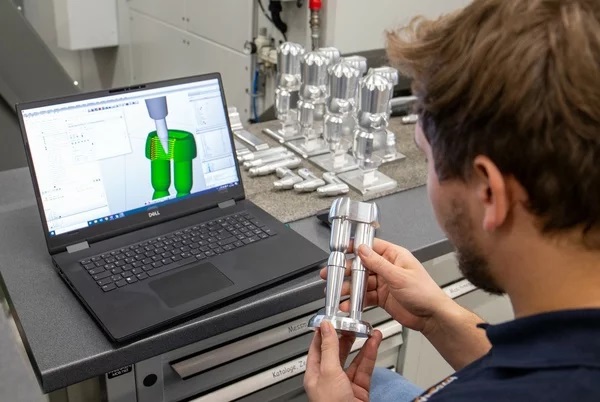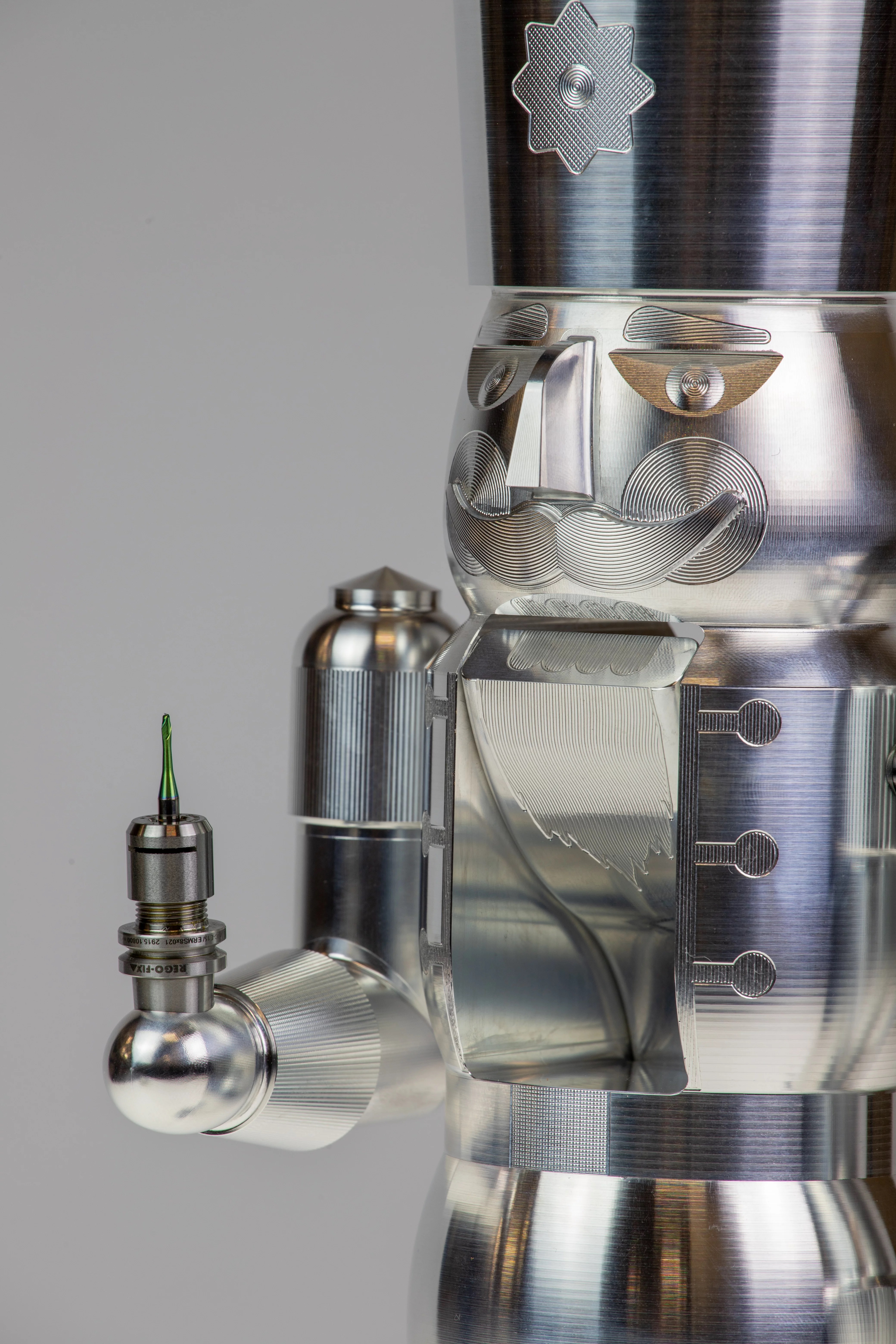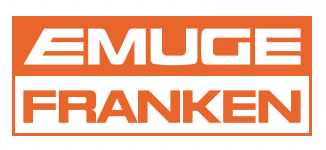
The Christmas season and its traditions may have faded into memory, but one traditional Christmas icon now has a metal counterpart that will last for many Christmases to come.
Open Mind, the developer of hyperMILL CAM software, created a replica of a famous nutcracker from the Erzgebirge a region in East Germany. The example is milled from aluminum and demonstrates an end-to-end digital process chain and efficient 5-axis machining with hyperMILL.
Together with Emuge-Franken, CAD/CAM developer Open Mind set itself a task: Digitally reproducing a 40-centimeter tall nutcracker as accurately as possible and mill it from aluminum as efficiently as possible. The traditional Seiffener Volkskunst nutcrackers provided the wooden figure, which was handcrafted in around 150 steps and consisted of around thirty individual parts.
From scan to surface model
Open Mind turned to WestCAM for the 3D scan of the nutcracker. The Austrian partner is characterized by its hyperMILL expertise, and it also has extensive know-how in 3D measurement technology. The scan resulted in a high-resolution mesh model consisting of 1.2 million triangles.
At Open Mind, a surface-based 3D model was created using the hyperMILL CAD/CAM solution and designed parametrically. The advantage of the latter is that production-related changes to the model can be made afterward. For production, the nutcracker model was divided into the upper part, legs, arms, and lever, which were pinned and glued together after completion.
Roughing and rest material machining
Production was carried out at Franken's Rückersdorf application center on a Hermle C32 machining center in a single clamping operation using 5-axis and 5-axis simultaneous processes. This allowed the surfaces to be machined continuously without segmentation.

The opening cut for the large central pocket of the upper body was efficiently achieved using 5-axis helical drilling, which enables a particularly high level of material removal and is also gentler on the tool than a helical plunging movement. Strategies from the hyperMILL MAXX Machining high-performance package were used to optimize roughing operations. The 5-axis rest machining function then ensured that the roughing was completed safely and efficiently.
The new EvoGrip centric clamp from Emuge was used for workpiece clamping. With its modular and slim system design, reliable clamping was guaranteed.
Finishing with circle segment end mill
The ‘high-precision surface’ mode was used for finishing, whereby hyperMILL® generates tool paths on the actual CAD surfaces and not on a calculation model. The large surfaces of the nutcracker that are curved in two directions, lent themselves to the use of FRANKEN's circle segment end mill in various shapes. For this application, taper and teardrop shape tools with cutting radii from 200mm to 1000mm were used. These tools, also known as barrel cutters, enable particularly efficient production of high-quality surfaces despite the large in-feeds or large step-over line increments. hyperMILL® offers optimum control of the cutting edge area of circle segment cutters.
Simulation and optimization in the virtual machine

"In the nutcracker machining example, we had the problem that the dimensions of the part were actually too large for the work area of the machine - a challenge that many manufacturers have already faced," explains Michael Förster, Senior Product Marketing Manager at OPEN MIND Technologies AG. "What would normally require many manual adjustments and individual simulations in order to avoid travel limitations and find safe tilt positions can now be implemented quickly and reliably thanks to the virtual machine and NC code-based simulation."
The hyperMILL® VIRTUAL Machining package includes an optimizer that perfectly adapts the connecting movements between the individual milling operations to the kinematics of the machine and can therefore solve limit switch problems. Communication between the milling center and the software, which contains a digital twin of the machine, allows precise machining based simulation of the actual NC code.
Another video for machining specialists
The machining videos from OPEN MIND and its partners are very popular. The nutcracker once again shows the advantages that can be gained from the optimum interaction of CAM, cutting tools and the machine. "We would like to thank EMUGE-FRANKEN, WESTCAM and Seiffener Volkskunst for their cooperation. We are delighted that we were able to impress the artisans from the Erzgebirge with the detailed execution of this adaptation of their original design," says Förster.
Contact Details
Related Glossary Terms
- computer-aided design ( CAD)
computer-aided design ( CAD)
Product-design functions performed with the help of computers and special software.
- computer-aided manufacturing ( CAM)
computer-aided manufacturing ( CAM)
Use of computers to control machining and manufacturing processes.
- gang cutting ( milling)
gang cutting ( milling)
Machining with several cutters mounted on a single arbor, generally for simultaneous cutting.
- machining center
machining center
CNC machine tool capable of drilling, reaming, tapping, milling and boring. Normally comes with an automatic toolchanger. See automatic toolchanger.
- milling
milling
Machining operation in which metal or other material is removed by applying power to a rotating cutter. In vertical milling, the cutting tool is mounted vertically on the spindle. In horizontal milling, the cutting tool is mounted horizontally, either directly on the spindle or on an arbor. Horizontal milling is further broken down into conventional milling, where the cutter rotates opposite the direction of feed, or “up” into the workpiece; and climb milling, where the cutter rotates in the direction of feed, or “down” into the workpiece. Milling operations include plane or surface milling, endmilling, facemilling, angle milling, form milling and profiling.
- milling machine ( mill)
milling machine ( mill)
Runs endmills and arbor-mounted milling cutters. Features include a head with a spindle that drives the cutters; a column, knee and table that provide motion in the three Cartesian axes; and a base that supports the components and houses the cutting-fluid pump and reservoir. The work is mounted on the table and fed into the rotating cutter or endmill to accomplish the milling steps; vertical milling machines also feed endmills into the work by means of a spindle-mounted quill. Models range from small manual machines to big bed-type and duplex mills. All take one of three basic forms: vertical, horizontal or convertible horizontal/vertical. Vertical machines may be knee-type (the table is mounted on a knee that can be elevated) or bed-type (the table is securely supported and only moves horizontally). In general, horizontal machines are bigger and more powerful, while vertical machines are lighter but more versatile and easier to set up and operate.
- numerical control ( NC)
numerical control ( NC)
Any controlled equipment that allows an operator to program its movement by entering a series of coded numbers and symbols. See CNC, computer numerical control; DNC, direct numerical control.
- step-over
step-over
Distance between the passes of the toolpath; the path spacing. The distance the tool will move horizontally when making the next pass. Too great of a step-over will cause difficulty machining because there will be too much pressure on the tool as it is trying to cut with too much of its surface area.
- surface model
surface model
3-D model defined by surfaces. The surface consists of polygons.

